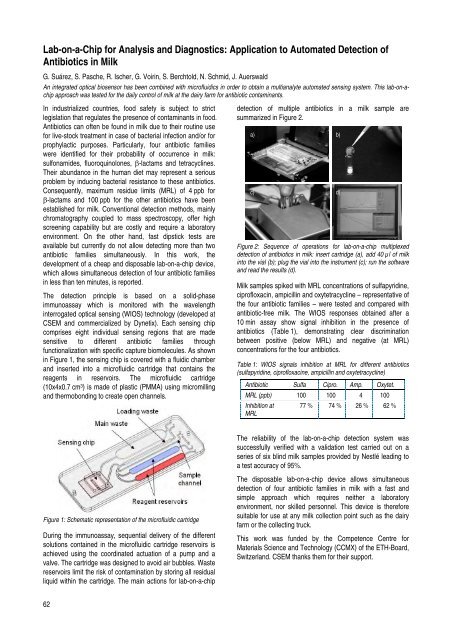CSEM Scientific and Technical Report 2008
CSEM Scientific and Technical Report 2008
CSEM Scientific and Technical Report 2008
Create successful ePaper yourself
Turn your PDF publications into a flip-book with our unique Google optimized e-Paper software.
Lab-on-a-Chip for Analysis <strong>and</strong> Diagnostics: Application to Automated Detection of<br />
Antibiotics in Milk<br />
G. Suárez, S. Pasche, R. Ischer, G. Voirin, S. Berchtold, N. Schmid, J. Auerswald<br />
An integrated optical biosensor has been combined with microfluidics in order to obtain a multianalyte automated sensing system. This lab-on-achip<br />
approach was tested for the daily control of milk at the dairy farm for antibiotic contaminants.<br />
In industrialized countries, food safety is subject to strict<br />
legislation that regulates the presence of contaminants in food.<br />
Antibiotics can often be found in milk due to their routine use<br />
for live-stock treatment in case of bacterial infection <strong>and</strong>/or for<br />
prophylactic purposes. Particularly, four antibiotic families<br />
were identified for their probability of occurrence in milk:<br />
sulfonamides, fluoroquinolones, β-lactams <strong>and</strong> tetracyclines.<br />
Their abundance in the human diet may represent a serious<br />
problem by inducing bacterial resistance to these antibiotics.<br />
Consequently, maximum residue limits (MRL) of 4 ppb for<br />
β-lactams <strong>and</strong> 100 ppb for the other antibiotics have been<br />
established for milk. Conventional detection methods, mainly<br />
chromatography coupled to mass spectroscopy, offer high<br />
screening capability but are costly <strong>and</strong> require a laboratory<br />
environment. On the other h<strong>and</strong>, fast dipstick tests are<br />
available but currently do not allow detecting more than two<br />
antibiotic families simultaneously. In this work, the<br />
development of a cheap <strong>and</strong> disposable lab-on-a-chip device,<br />
which allows simultaneous detection of four antibiotic families<br />
in less than ten minutes, is reported.<br />
The detection principle is based on a solid-phase<br />
immunoassay which is monitored with the wavelength<br />
interrogated optical sensing (WIOS) technology (developed at<br />
<strong>CSEM</strong> <strong>and</strong> commercialized by Dynetix). Each sensing chip<br />
comprises eight individual sensing regions that are made<br />
sensitive to different antibiotic families through<br />
functionalization with specific capture biomolecules. As shown<br />
in Figure 1, the sensing chip is covered with a fluidic chamber<br />
<strong>and</strong> inserted into a microfluidic cartridge that contains the<br />
reagents in reservoirs. The microfluidic cartridge<br />
(10x4x0.7 cm3 ) is made of plastic (PMMA) using micromilling<br />
<strong>and</strong> thermobonding to create open channels.<br />
Figure 1: Schematic representation of the microfluidic cartridge<br />
During the immunoassay, sequential delivery of the different<br />
solutions contained in the microfluidic cartridge reservoirs is<br />
achieved using the coordinated actuation of a pump <strong>and</strong> a<br />
valve. The cartridge was designed to avoid air bubbles. Waste<br />
reservoirs limit the risk of contamination by storing all residual<br />
liquid within the cartridge. The main actions for lab-on-a-chip<br />
62<br />
detection of multiple antibiotics in a milk sample are<br />
summarized in Figure 2.<br />
a) b)<br />
c) d)<br />
Figure 2: Sequence of operations for lab-on-a-chip multiplexed<br />
detection of antibiotics in milk: insert cartridge (a), add 40 µl of milk<br />
into the vial (b); plug the vial into the instrument (c); run the software<br />
<strong>and</strong> read the results (d).<br />
Milk samples spiked with MRL concentrations of sulfapyridine,<br />
ciprofloxacin, ampicillin <strong>and</strong> oxytetracycline – representative of<br />
the four antibiotic families – were tested <strong>and</strong> compared with<br />
antibiotic-free milk. The WIOS responses obtained after a<br />
10 min assay show signal inhibition in the presence of<br />
antibiotics (Table 1), demonstrating clear discrimination<br />
between positive (below MRL) <strong>and</strong> negative (at MRL)<br />
concentrations for the four antibiotics.<br />
Table 1: WIOS signals inhibition at MRL for different antibiotics<br />
(sulfapyridine, ciprofloxacine, ampicillin <strong>and</strong> oxytetracycline)<br />
Antibiotic Sulfa Cipro. Amp. Oxytet.<br />
MRL (ppb) 100 100 4 100<br />
Inhibition at<br />
MRL<br />
77 % 74 % 26 % 62 %<br />
The reliability of the lab-on-a-chip detection system was<br />
successfully verified with a validation test carried out on a<br />
series of six blind milk samples provided by Nestlé leading to<br />
a test accuracy of 95%.<br />
The disposable lab-on-a-chip device allows simultaneous<br />
detection of four antibiotic families in milk with a fast <strong>and</strong><br />
simple approach which requires neither a laboratory<br />
environment, nor skilled personnel. This device is therefore<br />
suitable for use at any milk collection point such as the dairy<br />
farm or the collecting truck.<br />
This work was funded by the Competence Centre for<br />
Materials Science <strong>and</strong> Technology (CCMX) of the ETH-Board,<br />
Switzerl<strong>and</strong>. <strong>CSEM</strong> thanks them for their support.








